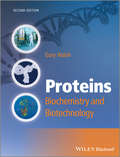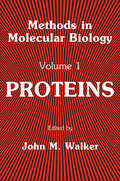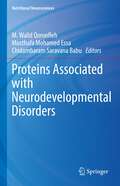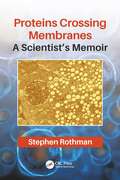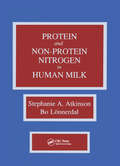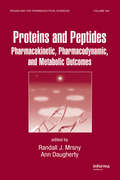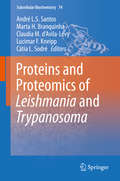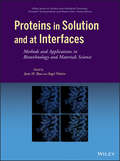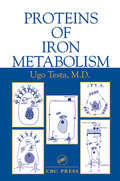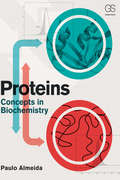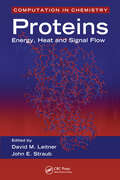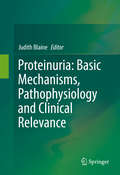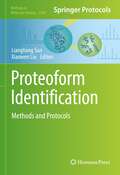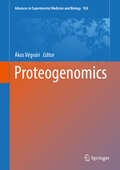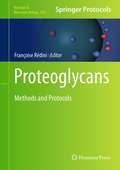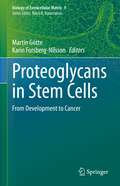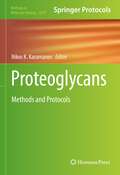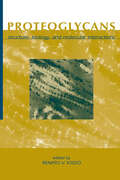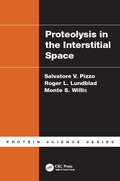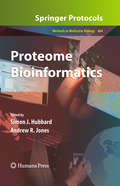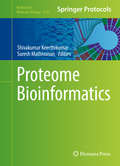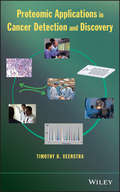- Table View
- List View
Proteins
by David WhitfordProteins: Structure and Function is a comprehensive introduction to the study of proteins and their importance to modern biochemistry. Each chapter addresses the structure and function of proteins with a definitive theme designed to enhance student understanding. Opening with a brief historical overview of the subject the book moves on to discuss the 'building blocks' of proteins and their respective chemical and physical properties. Later chapters explore experimental and computational methods of comparing proteins, methods of protein purification and protein folding and stability.The latest developments in the field are included and key concepts introduced in a user-friendly way to ensure that students are able to grasp the essentials before moving on to more advanced study and analysis of proteins.An invaluable resource for students of Biochemistry, Molecular Biology, Medicine and Chemistry providing a modern approach to the subject of Proteins.
Proteins
by Gary WalshProteins Biochemistry and Biotechnology 2e is a definitive source of information for all those interested in protein science, and particularly the commercial production and isolation of specific proteins, and their subsequent utilization for applied purposes in industry and medicine.Fully updated throughout with new or fundamentally revised sections on proteomics as, bioinformatics, protein glycosylation and engineering, well as sections detailing advances in upstream processing and newer protein applications such as enzyme-based biofuel production this new edition has an increased focus on biochemistry to ensure the balance between biochemisty and biotechnology, enhanced with numerous case studies.This second edition is an invaluable text for undergraduates of biochemistry and biotechnology but will also be relevant to students of microbiology, molecular biology, bioinformatics and any branch of the biomedical sciences who require a broad overview of the various medical, diagnostic and industrial uses of proteins. * Provides a comprehensive overview of all aspects of protein biochemisty and protein biotechnology* Includes numerous case studies * Increased focus on protein biochemistry to ensure balance between biochemisty and biotechnology* Includes new section focusing on proteomics as well as sections detailing protein function and enzyme-based biofuel production"With the potential of a standard reference source on the topic, any molecular biotechnologist will profit greatly from having this excellent book. " (Engineering in Life Sciences, 2004; Vol 5; No. 5)"Few texts would be considered competitors, and none compare favorably." (Biochemistry and Molecular Education, July/August 2002) "...The book is well written, making it informative and easy to read..." (The Biochemist, June 2002)
Proteins
by John M. WalkerOffers over 200 key, readily reproducible protocols that ensure robust, successful results Includes many new techniques for the study of post-translational modifications Demonstrates the range of techniques available and their strengths and limitations Contains numerous time-saving techniques for even the most highly skilled researchers Since the publication of the bestselling second edition of John Walkers widely acclaimed Protein Protocols Handbook, there have been continual methodological developments in the field of protein chemistry. This greatly enhanced third edition introduces 57 critically important new chapters, as well as significantly updating the previous editions tried-and-true methods. Although the timely new chapters are spread throughout all of the book, the vital section on post-translational modifications has been expanded most to reflect the increasing importance of these modifications in the understanding of protein function. Each readily reproducible method follows the highly praised format of the Methods in Molecular BiologyT series, offering a concise summary of its basic theory, a complete materials list, a step-by-step protocol for its successful execution, and extensive notes on avoiding pitfalls, or on modifying the method to function within your own experimental circumstances. The expert authors of each chapter have demonstrated a hands-on mastery of the methods described, fine-tuned here for optimal productivity. Comprehensive, cutting-edge, and highly practical, The Protein Protocols Handbook, Third Edition is todays indispensable benchtop manual and guide, not only for all those new to the protein chemistry laboratory, but also for those established workers seeking to broaden their armametarium of techniques in the urgent search for rapid and robust results.
Proteins Associated with Neurodevelopmental Disorders (Nutritional Neurosciences)
by M. Walid Qoronfleh Musthafa Mohamed Essa Chidambaram Saravana BabuThis book comprehensively reviews the proteins associated with neurodevelopmental disorders, including autism spectrum disorder (ASD) and attention deficit hyperactivity disorder (ADHD). It also discusses the interactions of the associated-proteins, like bromodomain-containing proteins (BCPs), kinases, synaptic proteins, scaffolding proteins, transcriptional factors, and DNA-binding proteins at the subcellular and molecular levels. The book also explores the potential of these proteins as a druggable target and a biomarker in the neurodevelopmental disorders. The book further explores the recent advancements in understanding the important role of epigenetic factors in predisposition to these diseases. Lastly, it presents genetic factors that lead to variation in gene expression in these diseases, disorders management via diet intervention and the future potential of stem cell therapy.
Proteins Crossing Membranes: A Scientist’s Memoir
by Stephen RothmanIn an intriguing series of experiments carried out many years ago, a common scientific belief, feted by no less than three Nobel prizes, was brought into question. The observations were about proteins—the molecules that the genetic code specifies and that are in one way or another central to all of life’s activities. The experiments however were not about what proteins do, but how they are moved, in particular how they are moved from where they are made to where they act. The results of these studies conflicted with the standard view of how this happens, and thus became controversial. The standard view, the vesicle theory of protein secretion, envisions proteins being carried within and out of cells en masse in membrane-bound sacs or vesicles. The controversial experiments demonstrated that to the contrary individual protein molecules cross the relevant membranes as a result of their own motion. This was thought to be impossible at the time. Proteins Crossing Membranes is a personal narrative that tells the story of the controversy. Among other things, the author illustrates that scientists, like the rest of us, can rigidly hold onto their beliefs despite evidence that they are misguided. Key Features Reviews the data in support and critical of the vesicle theory of protein secretion Explores the ways scientists respond to evidence that challenges a favored theory Documents the author’s personal experiences in this conflict-laden situation
Proteins and Non-protein Nitrogen in Human Milk
by Stephanie Atkinson Bo LonnerdalFor the first time, an entire publication has been dedicated to providing a critical review of the identification and analysis of the milk specific proteins such as lactalbumin, lactoferrin and casein; the non-milk specific proteins such as plasma and membrane proteins; and the minor nitrogen-containing components such as enzymes, hormones, and growth factors. Biological roles, whether nutritional, endocrinological or immunological, of the specific nitrogen compounds in mammary milk production and/or growth and development of the breast-fed infant are also presented. Identification of the molecular weight compounds that have led to questions about their function in milk and their inclusion in modern infant formulas is thoroughly discussed and of great value to scientists in sub-specialties of biochemistry, nutrition, physiology and immunology, as well as to pediatric practitioners with primary interests in the infant food industry, academia, or clinical nutrition. The thoroughness of each chapter, often providing an historical panorama of the specific aspect of milk composition, makes this book useful for both the uninitiated and expert audiences who are interested in advancing their knowledge of human milk biochemistry and its physiological significance to the recipient infant.
Proteins and Peptides: Pharmacokinetic, Pharmacodynamic, and Metabolic Outcomes (Drugs and the Pharmaceutical Sciences)
by Randall J. Mrsny Ann DaughertyAddressing the increased use of protein and peptide candidates as treatments for previously untreatable diseases, this comprehensive and progressive source provides the reader with a roadmap to an increased understanding of issues critical for successfully developing a protein or peptide therapeutic candidate. Proteins and Peptides is
Proteins and Proteomics of Leishmania and Trypanosoma
by André L. S. Santos Marta H. Branquinha Claudia M. d'Avila-Levy Lucimar F. Kneipp Cátia L. SodréThis book contains a collection of critical reviews on the expression of biologically functional proteins in Leishmania and Trypanosoma, which was written by renowned researchers on this field. Species belonging to these trypanosomatids' genera are etiological agents of leishmaniasis, Chagas' disease and sleeping sickness that are extremely debilitating human infection diseases, which remain a major health problem especially in countries from Latin America, Africa and Middle East. Substantiating the problem, the currently accepted drugs for these diseases are quiet unsatisfying due to their low efficacy and high toxicity. In order to solve these real problems, several research groups around the world have become involved in the study and identification of novel potential targets in the trypanosomatid cell. Since proteins are key macromolecules involved in crucial metabolic processes of all living cells, studies have focused on the expression of specific proteins produced by Leishmania and Trypanosoma by means of different biochemical, molecular and proteomic approaches in order to explore them as targets for understanding the parasite life cycle and developing new strategies against trypanosomiasis. With these proposals in mind, the book "Proteins and Proteomics of Leishmania and Trypanosoma" encompasses (i) an integrated view about the biochemistry of parasites belonging to the Leishmania and Trypanosoma genera; (ii) an updated review on the expression of biologically relevant proteins by human pathogenic trypanosomatids and their possible role in the interaction with host cells/molecules as well as a target for development of both alternative chemotherapies and vaccine; and (iii) several pictures, diagrams and tables that can be used to illustrate both undergraduate and postgraduate teaching as well as scientific lectures, being a useful resource for students and researchers.
Proteins in Solution and at Interfaces
by Ángel Piñeiro Juan M. RusoExplores new applications emerging from our latest understanding of proteins in solution and at interfacesProteins in solution and at interfaces increasingly serve as the starting point for exciting new applications, from biomimetic materials to nanoparticle patterning. This book surveys the state of the science in the field, offering investigators a current understanding of the characteristics of proteins in solution and at interfaces as well as the techniques used to study these characteristics. Moreover, the authors explore many of the new and emerging applications that have resulted from the most recent studies. Topics include protein and protein aggregate structure; computational and experimental techniques to study protein structure, aggregation, and adsorption; proteins in non-standard conditions; and applications in biotechnology.Proteins in Solution and at Interfaces is divided into two parts:Part One introduces concepts as well as theoretical and experimental techniques that are used to study protein systems, including X-ray crystallography, nuclear magnetic resonance, small angle scattering, and spectroscopic methodsPart Two examines current and emerging applications, including nanomaterials, natural fibrous proteins, and biomolecular thermodynamicsThe book's twenty-three chapters have been contributed by leading experts in the field. These contributions are based on a thorough review of the latest peer-reviewed findings as well as the authors' own research experience. Chapters begin with a discussion of core concepts and then gradually build in complexity, concluding with a forecast of future developments.Readers will not only gain a current understanding of proteins in solution and at interfaces, but also will discover how theoretical and technical developments in the field can be translated into new applications in material design, genetic engineering, personalized medicine, drug delivery, biosensors, and biotechnology.
Proteins of Iron Metabolism
by Ugo TestaProteins of Iron Metabolism presents a clear picture of the structure and function of the main proteins involved in iron metabolism. The book gives you a detailed description of the structure and function of each protein, and discusses the structure and regulation of the corresponding genes in parallel. It supplies an analysis of the differential e
Proteins of the Nucleolus
by Andrew Catalano Danton H O'DayThis book contains 14 original review chapters each yielding new, exciting and intriguing data about the emerging understanding of nucleolar structure and function in normal, stressed and diseased cells. The goal of this work is to provide special insight into the nucleolus of the past, present and future, as well its regulation, translocation, and biomedical function. A multitude of topics are introduced and discussed in detail, including nucleologenesis, nucleolar architecture, nucleolar targeting, retention, anchoring, translocation, and the relationship between the nucleolus and cancer. This book also brings together work from several different species, from human to Drosophila to Dictyostelium and other eukaryotic microbes. The final chapter summarizes some of the issues brought up in the various chapters with a view to future research. This book supports the continued emergence of the nucleolus as a dynamic intranuclear region that oversees a vast diversity of events.
Proteins: Concepts in Biochemistry
by Paulo AlmeidaProteins: Concepts in Biochemistry teaches the biochemical concepts underlying protein structure, evolution, stability and folding, and explains how interactions with macromolecular structures determine protein function. Intended for a one-semester biochemistry course with a focus on proteins, this textbook emphasizes the logic underlying biophysical chemical principles. Problems throughout the book encourage statistical and quantitative thinking. The text is ideal for senior undergraduates, first year graduate students, and practitioners in chemistry, biochemistry, biology, and biophysics.
Proteins: Energy, Heat and Signal Flow
by David M. Leitner John E. StraubComputational modeling can provide a wealth of insight into how energy flow in proteins mediates protein function. Computational methods can also address fundamental questions related to molecular signaling and energy flow in proteins. Proteins: Energy, Heat and Signal Flow presents state-of-the-art computational strategies for studying energy redi
Proteinuria: Basic Mechanisms, Pathophysiology and Clinical Relevance
by Judith BlaineRecent work has begun to elucidate at the molecular level how albumin is handled by the kidney and how albuminuria develops in various proteinuric diseases including minimal change disease and focal segmental glomerulosclerosis. This volume provides a comprehensive overview of the renal handling of albumin - from basic mechanisms to the pathophysiology of proteinuric diseases. In describing the basic mechanisms of albuminuria, a particular highlight will be the focus on advanced imaging techniques such as intravital microscopy that have allowed a detailed "window" into albumin transit through the kidney. The volume will cover the epidemiological studies which show that albuminuria is a strong and independent marker of kidney disease progression and cardiovascular events, the molecular details of albumin handling in the kidney at the level of the glomerulus and the proximal tubule and the pathophysiology of proteinuric diseases including minimal change disease, membranous nephropathy, focal segmental glomerulosclerosis and diabetic nephropathy.
Proteoform Identification: Methods and Protocols (Methods in Molecular Biology #2500)
by Liangliang Sun Xiaowen LiuThis volume discusses the latest mass spectrometry (MS)-based technologies for proteoform identification, characterization, and quantification. Some of the topics covered in this book include sample preparation, proteoform separation, proteoform gas-phase fragmentation, and bioinformatics tools for MS data analysis. Written in the highly successful Methods in Molecular Biology series format, chapters include introductions to their respective topics, lists of the necessary materials and reagents, step-by-step, readily reproducible laboratory protocols, and tips on troubleshooting and avoiding known pitfalls.Cutting-edge and comprehensive, Proteoform Identification: Methods and Protocols is a valuable resource for researchers in both academia and the biopharmaceutical industry who are interested in proteoform analysis using MS.
Proteogenomics
by Ákos VégváriThis book highlights key technologies and identifies areas for further development in proteogenomics. The utility and usefulness of very large Omics data sets (Next Gen Sequencing of DNA, RNA-seq, ribosome profiling, mass spectrometry- and antibody-based proteomics) is discussed and opportunities and challenges of related bioinformatics applications are outlined. The reader will be able to appreciate the interdisciplinary nature of the continuously evolving area of proteogenomics, which has already grown beyond its original concept of verifying gene annotations by proteomics. The chapters presented in this book are arranged to offer a general overview, rather than to provide detailed descriptions of technologies. The selected applications will provide useful insight into the level of detail that can be obtained in relation to certain diseases areas, including cancer biology and personalized medicine. The readers will find that each chapter delivers a comprehensive approach to proteogenomics, each from the point of view of a specific application. Research scientists interested in innovative processes that can offer a unique and at the same time a more complete access to technological developments and concepts that in turn can contribute to a better understand biological functions should read this book.
Proteoglycan Protocols
by Renato V. IozzoRenato Iozzo and an authoritative team of investigators present for the first time a comprehensive and up-to-date collection of readily reproducible preparative and analytical methods for the in-depth analysis of these important compounds. Featuring step-by-step protocols, this book will enable both novice and experienced researchers to isolate intact proteoglycans from tissues and cultured cells, to establish the composition of their carbohydrate moieties, and to generate strategies for prokaryotic and eukaryotic expression. There are also detailed techniques for the suppression of specific proteoglycan genes, for the detection of mutant cells and their degradation products, and for studying specific interactions between proteoglycans and extracellular matrix proteins and with growth factors and their receptors.
Proteoglycans
by Françoise RédiniNow recognized as a reservoir for growth factors and cytokines modulating cell activation status and turnover, proteoglycans have stimulated great amount of interest and research. In Proteoglycans: Methods and Protocols, experts in the field examine issues of basic concepts and up-to-date analysis methods for proteoglycan and glycosaminoglycan (GAG) at the protein and saccharide levels. The volume continues with the multifunctional aspect of proteoglycans, highlighted through three relevant examples of proteoglycans with highly different strucutures: serglycin, aggrecan, and heparin sulphate proteoglycans. The final chapter describes proteoglycan involvement in the pathogenesis of various disorders and their potential therapeutic value in osteo-articular diseases. Written in the highly successful Methods in Molecular BiologyTM series format, chapters include introductions to their respective topics, lists of the necessary materials and reagents, step-by-step, readily reproducible laboratory protocols, and tips on troubleshooting and avoiding known pitfalls. Authoritative and accessible, Proteoglycans: Methods and Protocols is an ideal guide for scientists attempting to pursue further research in this vital and complex area of study.
Proteoglycans in Stem Cells: From Development to Cancer (Biology of Extracellular Matrix #9)
by Martin Götte Karin Forsberg-NilssonThis book provides a state-of-the-art compendium on the role of proteoglycans and glycosaminoglycans during development and in cancer. It also suggests directions for novel therapeutic and biotechnological applications in stem cell biology. Proteoglycans and glycosaminoglycans, as part of the extracellular matrix, are multifunctional modulators of growth factor, cytokine, integrin and morphogen signaling, which determine both self-renewal, senescence and/or differentiation of stem cells during development. Since proteoglycans modulate cell adhesion and migration they are important organizers of the extracellular matrix within the proper stem cell niche. A malfunctioning of proteoglycans and glycosaminoglycans contributes to the cancer stem cell phenotype, which is linked to therapeutic resistance and recurrence in malignant disease. This book is essential reading for anyone interested in the extracellular matrix and its role in development.The series Biology of Extracellular Matrix is published in collaboration with the American Society for Matrix Biology.
Proteoglycans: Methods and Protocols (Methods in Molecular Biology #2619)
by Nikos K. KaramanosThis volume is a comprehensive and up-to-date collection of strategies, reproducible methods, and protocols for the in-depth analysis of Proteoglycans (PGs) and their glycan part, the GAGs. Chapters are divided into three parts detailing GAGs in biological specimens, protocols for the evaluation of the in vitro and in vivo effects of PGs/GAGs, and protocols for compounds related with the metabolic enzymes, epigenetic regulation, and PGs/GAGs-based inhibitors. Written in the format of the highly successful Methods in Molecular Biology series, each chapter includes an introduction to the topic, lists necessary materials and methods, includes tips on troubleshooting and known pitfalls, and step-by-step, readily reproducible protocols. Cutting-edge and thorough, Proteoglycans: Methods and Protocols aims to provide information on the elucidated the structural and functional aspects of the complex matrix macromolecules such as the proteoglycans and glycosaminoglycans.
Proteoglycans: Structure, Biology And Molecular Interactions
by Jessica KeyesThis book provides a comprehensive, up-to-date review of the structure, biology, and molecular interactions of proteoglycans, consolidating into a single source research using molecular, cellular, and animal systems. Of particular note is an in-depth look at the role of heparan sulfate in modulating growth factors and morphogens.
Proteolysis in the Interstitial Space
by Monte S. Willis Roger L. Lundblad Salvatore V. PizzoMost clinical laboratory tests utilize interstitial and extravascular such as blood, urine, cerebral spinal fluid (CSF), and saliva. For example, CSF is monitored in the context of cancer for both diagnostic and therapeutic reasons. And yet, our understanding of the makeup of interstitial fluids, their relationships to disease, as well as their commercial importance in therapeutics and diagnostics remains rudimentary. Although sometimes perceived as static, interstitial and extravascular fluids are surprisingly dynamic. More than half of serum albumin is in the extravascular space. These fluids move rapidly between the intravascular and extravascular spaces - one entire plasma volume is exchanged very nine hours. In the first half of the book, the authors cover fundamental concepts of interstitial fluids, including their composition and function. They then further review the mechanisms by which interstitial fluids are regulated, characterizing the importance of hyaluronan – a major constituent of interstitial spaces and an a component of synovial fluid; and, outlining the regulation of proteolysis in the interstitial space. In the second half of the book, the authors focus on the coagulation system. This system has been studied extensively in the context of vascular spaces. But many of its components exist in the interstitial spaces. Chapters are devoted to the fibrinolytic system, kallikrein, matrix metalloproteinases, coagulation factors, and protease inhibitors – all are interstitial. By covering a unique array of topics with broad application to biomedical scientists, this book expands our understanding of the importance of interstitial spaces and the fluids that move through and reside in this extravascular environment.
Proteome Bioinformatics
by Andrew R. Jones Simon J. HubbardThe field of proteomics moves rapidly, as new methods, techniques, applications, standards, models and software appear almost on a daily basis. In Proteome Bioinformatics, expert researchers explore this ever-changing field, providing the reader with a mix of review and methodology chapters which address the fundamentals of analysis methods, algorithms, data standards and databases. Chapters include practical considerations for analyzing database search results, annotating genomes, speeding up searches, and responding to specific data processing challenges. As a volume of the highly successful Methods in Molecular Biology series, this work provides the kind of detailed description and implementation advice that is crucial for getting optimal results. Comprehensive and ground-breaking, Proteome Bioinformatics is an essential guidebook for the novice and expert alike, covering topics that address a wide range of data analysis and management problems.
Proteome Bioinformatics
by Shivakumar Keerthikumar Suresh MathivananThis thorough book covers the most recent proteomics techniques, databases, bioinformatics tools, and computational approaches that are used for the identification and functional annotation of proteins and their structure. The most recent proteomic resources widely used in the biomedical scientific community for storage and dissemination of data are discussed. In addition, specific MS/MS spectrum similarity scoring functions and their application in the field of proteomics, statistical evaluation of labeled comparative proteomics using permutation testing, and methods of phylogenetic analysis using MS data are also described in detail. Written for the highly successful Methods in Molecular Biology series, chapters contain the kind of detail and key implementation advice to ensure successful results. Authoritative and cutting-edge, Proteome Bioinformatics serves as a useful resource for researchers who are beginners as well as advanced investigators in the field of proteomics.
Proteomic Applications in Cancer Detection and Discovery
by Timothy D. VeenstraHelps researchers in proteomics and oncology work together to understand, prevent, and cure cancer Proteomic data is increasingly important to understanding the origin and progression of cancer; however, most oncologic researchers who depend on proteomics for their studies do not collect the data themselves. As a result, there is a knowledge gap between scientists, who devise proteomic techniques and collect the data, and the oncologic researchers, who are expected to interpret and apply proteomic data. Bridging the gap between proteomics and oncology research, this book explains how proteomic technology can be used to address some of the most important questions in cancer research. Proteomic Applications in Cancer Detection and Discovery enables readers to understand how proteomic data is acquired and analyzed and how it is interpreted. Author Timothy Veenstra has filled the book with examples-many based on his own firsthand research experience-that clearly demonstrate the application of proteomic technology in oncology research, including the discovery of novel biomarkers for different types of cancers. The book begins with a brief introduction to systems biology, explaining why cancer is a systems biology disease. Next, it covers such topics as: Mass spectrometry in cancer research Application of proteomics to global phosphorylation analysis Search for biomarkers in biofluids Rise and fall of proteomic patterns for cancer diagnostics Emergence of protein arrays Role of proteomics in personalized medicine The final chapter is dedicated to the future prospects of proteomics in cancer research. By guiding readers through the latest proteomic technologies and their applications in cancer research, Proteomic Applications in Cancer Detection and Discovery enhances the ability of researchers in proteomics and researchers in oncology to collaborate in order to better understand cancer and develop strategies to prevent and treat it.

